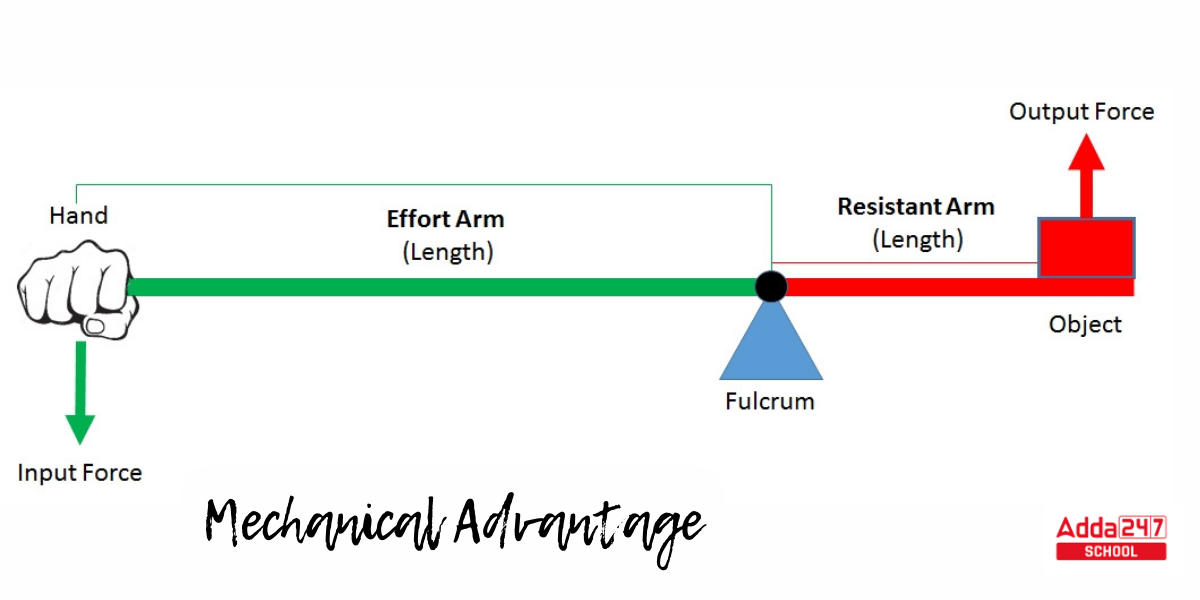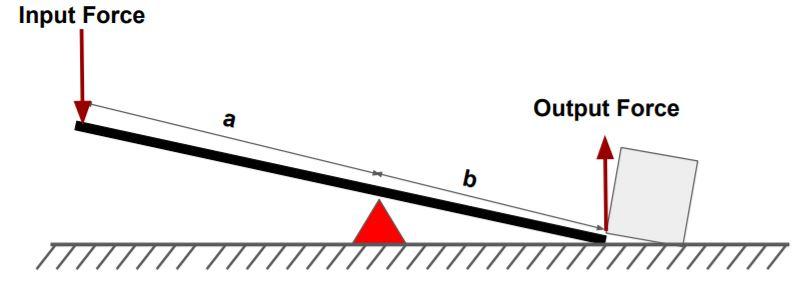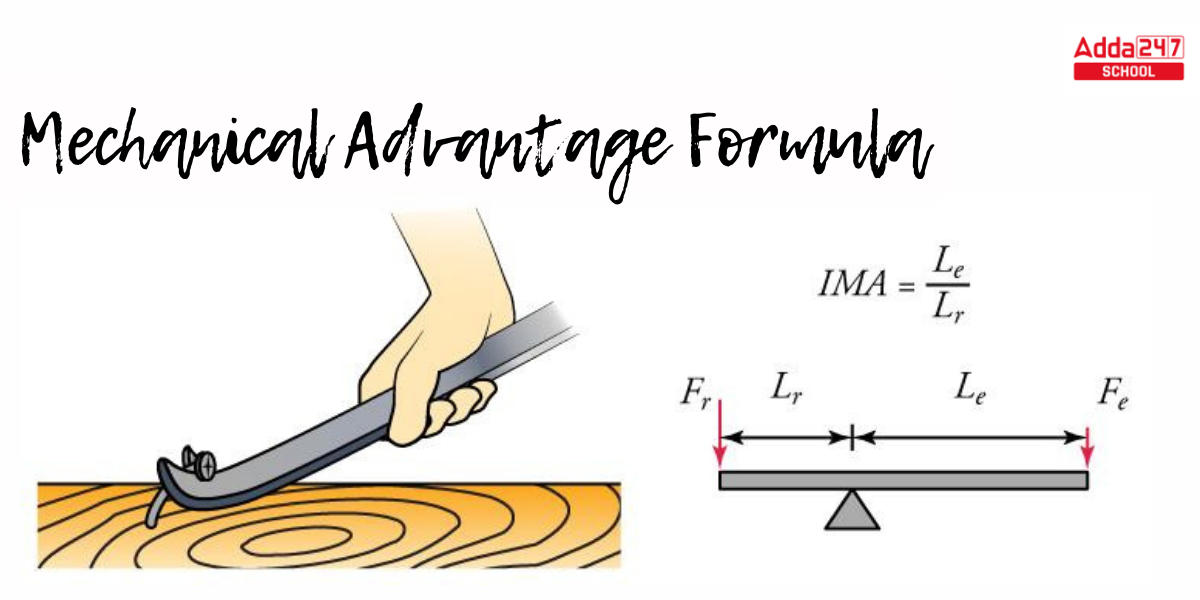Table of Contents
Mechanical Advantage Formula: The ratio of input force to output force is referred to as mechanical advantage Formula. Mechanical advantage can be utilized to evaluate a machine’s performance and quantify the mechanical system’s gain in force. In terms of mathematics, mechanical advantage is defined as the ratio of output force to input force. This mechanical advantage is used to analyze the forces in machines, which can be simple levers or complicated machinery. Mechanical advantage is another term that can be used as the force generated by the machine in response to the force given to it. The mechanical advantage Formula, example, unit, and other facts are covered in the next section of the article.
Mechanical Advantage Formula
Mechanical Advantage Formula makes use of the force amplification that we get by using a device or an entire mechanical system. The quantity of energy transferred when a body is pushed by an external force transmitted in the direction of displacement is referred to as work. Work done is therefore a combination of displacement or distance and force. A large force delivered over a short distance and a little force applied over a long distance can both perform the same amount of labour. Thus, Mechanical Advantage Formula is defined as the ratio of input force to output force. The degree to which friction and other variables reduce the machine’s real work production influences the machine’s efficiency. A frictionless machine can be completely efficient.
What is Mechanical Advantage?
Mechanical advantage can alternatively be defined as the force generated by the machine in response to the force given to it. This mechanical advantage formula is used to analyze the forces in machines, which can be simple levers or complicated machinery. These machines practice energy conservation. In some circumstances, the output force is equal to the input force, resulting in a mechanical advantage of one. The value of mechanical advantage can be more than 1 if the input force is less than the output force, and it can also be less than 1 if the input force is greater than the output force. The conservation of energy is valid in all of these machine situations.
Mechanical Advantage Formula
Mechanical advantage is defined as the ratio of force applied to an item (input force) to the effort required to overcome that force (output force). When we study the mechanics of the lever, we use the term mechanical advantage. Mechanical advantage is a word that is commonly used in the context of physical, simple machinery. In many cases, a user will exert an external force over a long distance in order to complete task.
As a result, the mechanical advantage formula is as follows:

MA = Mechanical Advantage Formula.
FA = Effort to overcome the imposed force
FB = Force of the object
The ratio of real mechanical advantage to predicted mechanical advantage equals machine efficiency. In an ideal world, the object’s force and the force used to counteract the applied force are the same.

Mechanical Advantage Formula Example
Some applications are used to overcome friction in any real machine. As a result, the ratio of resisting force to effort is known as the true mechanical advantage, which will be relatively small. A machine’s efficiency is always calculated by relating its output to its input. The machine’s efficiency is also equal to the ratio of real mechanical advantage to theoretical mechanical advantage. However, this does not exclude out the usage of low-efficiency machinery.
For example, a vehicle jack must overcome significant friction, resulting in low efficiency. However, it is astonishingly worthwhile because a tiny effort can be used to lift a large weight.
Calculate the value of Mechanical Advantage when a 500 Newton force is required to overcome a 2000 Newton load.
we must determine the machine’s mechanical advantage.
The effort required to overcome the imposed force = 2000 N = FB
The object’s force = 500 N = FA
Mechanical Advantage Formula = FB / FA
Therefore, 2000 / 500 = Mechanical Advantage
Mechanical Advantage = 4
Finally, we can say that the Mechanical Advantage has a value of 4.
Mechanical Advantage Formula Unit
In Mechanical Advantage, there is no Unit. Because both components in the mechanical advantage formula (force) and unit are the same, mechanical advantage is a dimensionless characteristic.
The Mechanical Advantage Formula is –

MA stands for Mechanical Advantage Formula. FA stands for Effort to overcome the imposed force, and FB stands for Force of the object. Mechanical Advantage lacks a Unit.
The efficiency of any machine predicts how much friction and other variables reduce the machine’s real work production from its theoretical maximum value. A frictionless machine would undoubtedly be 100% efficient. As a result, a machine with a 20% efficiency will produce just 1/15th of its theoretical output.
Mechanical Advantage Formula Factors
Mechanical Advantage is used to evaluate a machine’s performance. It is used to calculate the mechanical system’s gain in force. Some important aspects of the Mechanical Advantage Formula are addressed below.
- The ratio of input force to output force is referred to as mechanical advantage.
- Mechanical advantage is a term that is frequently used in regard to simple machinery. It is employed for researching the mechanism and operation of a lever.
- The ratio of real mechanical advantage to predicted mechanical advantage equals machine efficiency.
- The force of the item and the force applied to counteract the applied force are the same in an ideal example of mechanical advantage.
Mechanical Advantage Formula Based Examples Questions Answers
Let’s go through some questions to help you understand the Mechanical Advantage Formula better.
Mechanical Advantage Formula Example 1: Calculate the mechanical advantage if 500 N of force is required to overcome a 900 N weight.
We have, FA = 500 N
FB = 900 N
MA = FB / FA is the mechanical advantage formula.
MA = 900 / 500
MA = 1.8
Mechanical Advantage Formula Example 2: what is mechanical advantage with Example?
Mechanical advantage is the increase in applied force caused by the use of a mechanical device, tool, or mechanism, such as a lever, gear, or pulley system. As an example, A man uses a lever to lift a heavy block, as depicted below.

Mechanical Advantage Formula Example 3: What power is necessary to overcome a weight of 810 Newton if the lever’s mechanical advantage is 9?
In the above question, we must determine the object’s force.
MA = Mechanical Advantage = 9
The effort required to overcome the imposed force = 810 N= FB
To determine the object’s force (FA), follow these steps:
FM = FB/FA
9 = 810 / FA
FB / MA = FA
FA = 810/ 9
FA = 90 N
As a result, the object’s force is 90 Newton.


 NEET Admit Card 2024 Download Link Out a...
NEET Admit Card 2024 Download Link Out a...
 TS ECET Hall Ticket 2024 Out @ecet.tsche...
TS ECET Hall Ticket 2024 Out @ecet.tsche...
 ISC 12th Result 2024 Date, Check ISC Cla...
ISC 12th Result 2024 Date, Check ISC Cla...















